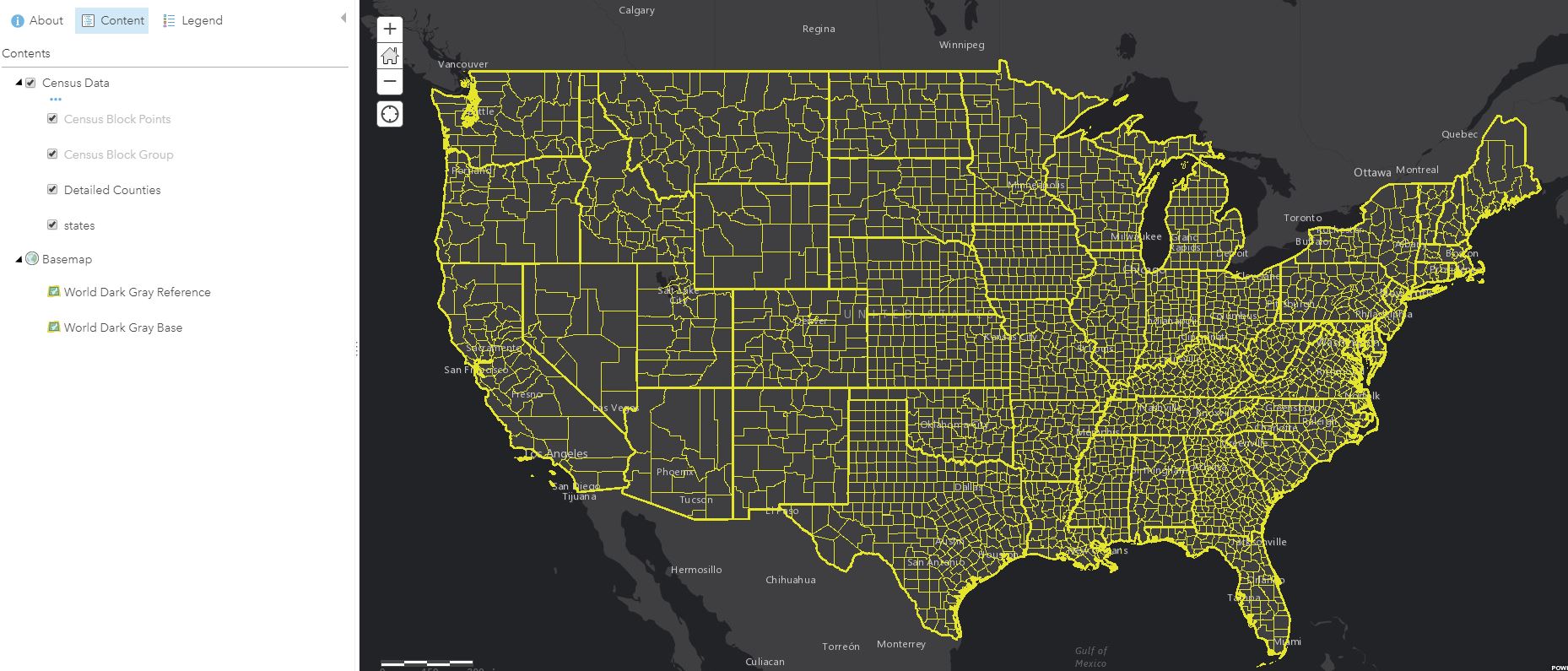HOW TO
Create a web map from a JSON file using ArcGIS API for Python version 2.3 and prior
Summary
In some cases, it is favorable to create a web map using a script, as it can be programmed for multiple web maps. Using the definition specified in a JSON file, the gis.content.add function in ArcGIS API for Python version 2.3 and prior can be used to create the web map.
Procedure
Web maps can be created from a JSON file representation using the gis.content.add function in the GIS module. There are two ways to do :
- Reading the JSON file within the script.
- Defining the JSON description in the script.
Note: Defining the JSON description is a longer process. However, it gives the user the ability to modify the JSON representation of the script.
The steps below describe how to create a web map from a JSON file by reading it using the json module.
-
Import the necessary modules.
from arcgis.gis import GIS from arcgis.mapping import WebMap import json
- Specify the login credentials.
gis = GIS('https://<machine>.<domain>/<web adaptor name>/home', 'username', 'password', verify_cert=False)
print ('Connected')
- Open the JSON file.
with open('/home/jupyter/test2.json') as json_data:
data = json.load(json_data)
- Create the new map.
item_properties_dict = {"type": "Web Map","title": "Test Map","tags": ["test","test1","test2"],"snippet":"This is a snippet", "text":data}
newmap = gis.content.add(item_properties = item_properties_dict)
newmap
The following shows the full script:
from arcgis.gis import GIS
from arcgis.mapping import WebMap
import json
gis = GIS('https://<machine>.<domain>/<web adaptor name>/home', 'username', 'password', verify_cert=False)
print ('Connected')
with open('/home/jupyter/test2.json') as json_data:
data = json.load(json_data)
item_properties_dict = {"type": "Web Map","title": "Test Map","tags": ["test","test1","test2"],"snippet":"This is a snippet", "text":data}
newmap = gis.content.add(item_properties = item_properties_dict)
newmap
The steps below describe how to create a web map by defining the JSON description in the script.
- Follow steps 1 and 2 from the method above.
- Define the dictionary containing the JSON used to create the web map.
data = {
"operationalLayers": [{
"id": "layer_2382",
"layerType": "ArcGISMapServiceLayer",
"url": "https://sampleserver6.arcgisonline.com/arcgis/rest/services/Census/MapServer",
"visibility": True,
"opacity": 1,
"title": "Census Data",
"layers": [{
"id": 0,
"layerDefinition": {
"source": {
"type": "mapLayer",
"mapLayerId": 0
}
},
"name": "Census Block Points",
"minScale": 99999.99998945338,
"maxScale": 0,
"parentLayerId": -1,
"defaultVisibility": True
}, {
"id": 1,
"layerDefinition": {
"source": {
"type": "mapLayer",
"mapLayerId": 1
},
"drawingInfo": {
"renderer": {
"type": "simple",
"label": "",
"description": "",
"symbol": {
"color": [0, 0, 0, 0],
"outline": {
"color": [230, 230, 0, 255],
"width": 0.39975000000000005,
"type": "esriSLS",
"style": "esriSLSSolid"
},
"type": "esriSFS",
"style": "esriSFSSolid"
}
}
}
},
"name": "Census Block Group",
"minScale": 1000000,
"maxScale": 0,
"parentLayerId": -1,
"defaultVisibility": True
}, {
"id": 2,
"layerDefinition": {
"source": {
"type": "mapLayer",
"mapLayerId": 2
},
"drawingInfo": {
"renderer": {
"type": "simple",
"label": "",
"description": "",
"symbol": {
"color": [0, 0, 0, 0],
"outline": {
"color": [230, 230, 0, 255],
"width": 0.5625,
"type": "esriSLS",
"style": "esriSLSSolid"
},
"type": "esriSFS",
"style": "esriSFSSolid"
}
}
}
},
"name": "Detailed Counties",
"minScale": 0,
"maxScale": 0,
"parentLayerId": -1,
"defaultVisibility": True
}, {
"id": 3,
"layerDefinition": {
"source": {
"type": "mapLayer",
"mapLayerId": 3
},
"drawingInfo": {
"renderer": {
"type": "simple",
"label": "",
"description": "",
"symbol": {
"color": [0, 0, 0, 0],
"outline": {
"color": [230, 230, 0, 255],
"width": 2,
"type": "esriSLS",
"style": "esriSLSSolid"
},
"type": "esriSFS",
"style": "esriSFSSolid"
}
}
}
},
"name": "states",
"minScale": 0,
"maxScale": 0,
"parentLayerId": -1,
"defaultVisibility": True
}
]
}
],
"baseMap": {
"baseMapLayers": [{
"id": "labels",
"layerType": "ArcGISTiledMapServiceLayer",
"url": "https://services.arcgisonline.com/arcgis/rest/services/Canvas/World_Dark_Gray_Base/MapServer",
"visibility": True,
"opacity": 1,
"title": "World_Dark_Gray_Base"
}, {
"id": "base",
"layerType": "ArcGISTiledMapServiceLayer",
"url": "https://services.arcgisonline.com/arcgis/rest/services/Canvas/World_Dark_Gray_Reference/MapServer",
"visibility": True,
"opacity": 1,
"title": "World_Dark_Gray_Reference"
}
],
"title": "Basemap"
},
"spatialReference": {
"wkid": 102100,
"latestWkid": 3857
},
"authoringApp": "WebMapViewer",
"authoringAppVersion": "10.6.1",
"version": "2.11"
}
- Create the new map.
item_properties_dict = {"type": "Web Map","title": "Test Map","tags": ["test","test1","test2"],"snippet":"This is a snippet", "text":data}
newmap = gis.content.add(item_properties = item_properties_dict)
newmap
The following shows the full script:
from arcgis.gis import GIS
from arcgis.mapping import WebMap
gis = GIS('https://<machine>.<domain>/<web adaptor name>/home', 'username', 'password', verify_cert=False)
print ('Connected')
data = {
"operationalLayers": [{
"id": "layer_2382",
"layerType": "ArcGISMapServiceLayer",
"url": "https://sampleserver6.arcgisonline.com/arcgis/rest/services/Census/MapServer",
"visibility": True,
"opacity": 1,
"title": "Census Data",
"layers": [{
"id": 0,
"layerDefinition": {
"source": {
"type": "mapLayer",
"mapLayerId": 0
}
},
"name": "Census Block Points",
"minScale": 99999.99998945338,
"maxScale": 0,
"parentLayerId": -1,
"defaultVisibility": True
}, {
"id": 1,
"layerDefinition": {
"source": {
"type": "mapLayer",
"mapLayerId": 1
},
"drawingInfo": {
"renderer": {
"type": "simple",
"label": "",
"description": "",
"symbol": {
"color": [0, 0, 0, 0],
"outline": {
"color": [230, 230, 0, 255],
"width": 0.39975000000000005,
"type": "esriSLS",
"style": "esriSLSSolid"
},
"type": "esriSFS",
"style": "esriSFSSolid"
}
}
}
},
"name": "Census Block Group",
"minScale": 1000000,
"maxScale": 0,
"parentLayerId": -1,
"defaultVisibility": True
}, {
"id": 2,
"layerDefinition": {
"source": {
"type": "mapLayer",
"mapLayerId": 2
},
"drawingInfo": {
"renderer": {
"type": "simple",
"label": "",
"description": "",
"symbol": {
"color": [0, 0, 0, 0],
"outline": {
"color": [230, 230, 0, 255],
"width": 0.5625,
"type": "esriSLS",
"style": "esriSLSSolid"
},
"type": "esriSFS",
"style": "esriSFSSolid"
}
}
}
},
"name": "Detailed Counties",
"minScale": 0,
"maxScale": 0,
"parentLayerId": -1,
"defaultVisibility": True
}, {
"id": 3,
"layerDefinition": {
"source": {
"type": "mapLayer",
"mapLayerId": 3
},
"drawingInfo": {
"renderer": {
"type": "simple",
"label": "",
"description": "",
"symbol": {
"color": [0, 0, 0, 0],
"outline": {
"color": [230, 230, 0, 255],
"width": 2,
"type": "esriSLS",
"style": "esriSLSSolid"
},
"type": "esriSFS",
"style": "esriSFSSolid"
}
}
}
},
"name": "states",
"minScale": 0,
"maxScale": 0,
"parentLayerId": -1,
"defaultVisibility": True
}
]
}
],
"baseMap": {
"baseMapLayers": [{
"id": "labels",
"layerType": "ArcGISTiledMapServiceLayer",
"url": "https://services.arcgisonline.com/arcgis/rest/services/Canvas/World_Dark_Gray_Base/MapServer",
"visibility": True,
"opacity": 1,
"title": "World_Dark_Gray_Base"
}, {
"id": "base",
"layerType": "ArcGISTiledMapServiceLayer",
"url": "https://services.arcgisonline.com/arcgis/rest/services/Canvas/World_Dark_Gray_Reference/MapServer",
"visibility": True,
"opacity": 1,
"title": "World_Dark_Gray_Reference"
}
],
"title": "Basemap"
},
"spatialReference": {
"wkid": 102100,
"latestWkid": 3857
},
"authoringApp": "WebMapViewer",
"authoringAppVersion": "10.6.1",
"version": "2.11"
}
item_properties_dict = {"type": "Web Map","title": "Test Map","tags": ["test","test1","test2"],"snippet":"This is a snippet", "text":data}
newmap = gis.content.add(item_properties = item_properties_dict)
newmap
The image below shows the newly created web map.

Article ID: 000019701
- Portal for ArcGIS
- ArcGIS Server
- ArcGIS API for Python
Get help from ArcGIS experts
Start chatting now

